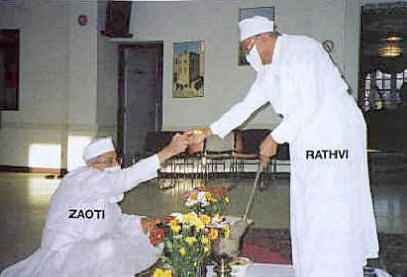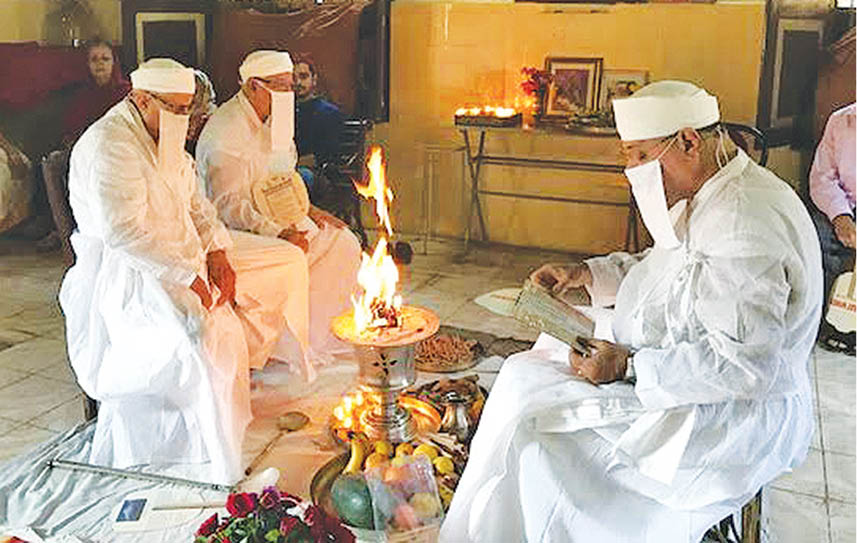
A Jasan (the Indian-Zoroastrian word) or jashne (the Iranian-Zoroastrian word) is a religious thanksgiving ceremony, or one that celebrates or commemorates an important event.
Jasan means celebration or festival in parasi. Jasan (thanksgiving ceremony) is derived from jashne as well as the Avestan word yasna , we called it Yajna in Vedic Sanskrit. A jasan / jashne is therefore a name for an event that is part of the Zoroastrian calendar such as Jashne Mehergan, as well as the religious ceremony conducted during a special occasion.
Amongst jasans conducted during a special occasion, there are public and private jasans/jashnes. Private jasans/jashnes are conducted for occasions such as the birth of a child, an anniversary, an engagement, House warming, graduation or any event where a person or family deems worthy of a religious ceremony of thanks and blessing.
Customarily, all Zoroastrian religious ceremonies are conducted on a white linen sheet, called a sofreh, spread on the floor. The sofreh represents the sacred space during the jashan / jashne ceremony. The sofreh is spread placed over a carpet that is placed in the centre of the room, with chairs for the participants arranged around the sofreh. White is the symbol of cleanliness, purity, and goodness.
The utensils used in the ceremony are metal. The include the afarganyu or fire urn, a couple or more metal trays called a sace or ses, a chamach or ladle for placing wood and incense (loban) on the fire, and a chipyo or tongs used to move items.
Jasan Symbolism
The jasan / jashne ceremonies of which the Afringan described below is a part, celebrate the coexistent duality of existence: the spiritual and material creations (thanksgiving ceremony).
The eight flowers can be arranged in the tray or sace that is placed on the sofreh. The two rows represent the spiritual existence, mainyu / mainyva , and gaetha / gaethya, material or physical, existences (in later language: menog and getig). The climactic moment of the ceremony is when the priests pick up and exchange the flowers with the words “athe zamyat” symbolizing the interchange or an interaction between the two realms of existence. The exchange of flowers which are picked up from the top of one row followed by flowers from the bottom of the other parallel row, also symbolizes the transmigration of righteous souls, the united fravashis of the righteous between the two realms.
The seven aspects of creation and the corresponding Amesha Spentas (divine attributes) together with spenta mainyu, are represented in the setting and items used in the ceremony:
• The floor or ground represents the earth and the Amesha Spenta Armaiti;
• The fire represents the eternal flame, the spiritual fire, and the Amesha Spenta Asha;
• The priest represents human kind and Spenta Mainyu;
• Milk represents animal life and the Amesha Spenta Vohu Mano;
• The metal in the utensils represents the sky and the Amesha Spenta Khshathra;
• Water represents water, the environment and the Amesha Spenta Haurvatat;
• The flowers and fruit represent vegetation and the Amesha Spenta Amertat.
The ceremonial tray, the sace, represents as it were, the celestial sphere and all aspects of creation including the spiritual and physical realms.
Priests
The jashan ceremony can be conducted by one, two or more priests. If there are two priests, the senior priest is known as the Zaotar or Zaoti and his assistant is called the Raspi or Rathvi. The priest(s) wears a white tunic called a jama. His mouth and nose are covered to prevent his breath from blowing on to the fire. Everyone partaking in the prayers, including the priest(s) cover their heads during the prayer ceremony.

Prayers
Three groups of prayers are often recited at jashan / jashne ceremonies. Together they form the larger Afringan service:
Atash Nyaish and Doa-Nam Satayashne
The Atash Nyaish is a litany to the fire – prayers said when consecrating a fire used as part of a ceremony.
The Doa-Nam Satayashne (or Stayishn) are words in praise of God in the Pahlavi language.
Dibache, Afringans and Afrins
Afringans are dedications to God, God’s creation, divine attributes and angels. An Afringan is also called a flower ceremony as the flowers placed in the sace or ses are held up or, if two or more priests are present, exchanged between the priests during recitation of the Afringan. The choice of Afringan depends of the occasion.
The Afringan is prefaced by a prayer composed in Pazend or Persian called a dibache or a preface to the Avestan prayers and a remembrance of the souls of the departed, including great kings of Zoroastrian history, heroes, priests and deceased members of the family sponsoring the Jashan. The dibache is recited in a soft tone.
The Afrin are prayers of blessing where the priest or person saying the prayers seeks to spread the spiritual strength of the ceremony to all present. The Afringan ceremony is explained further in our page on Liturgical Ceremonies and avesta.org’s page on the subject. After the flower ceremony, the priest touches the different metal vessels with his metal fire-tongs in the four directions of the compass and then again in the directions in-between the four compass points.
Doa Tandorosti
These Pazand prayers are the culmination of the prayer ceremony. The first two steps enable blessings of strength, health, and well-being to be extended to all present, and indeed all of humankind as well as the souls of the departed. If the occasion honours particular individuals, their names are mentioned in the benediction. In Persian, tan means body and dorost means correct or healthy in this case.
At the end the prayers, the priest may asks the gathering to stand, hold hands and join in prayer. This is an act of solidarity and community. The prayers are usually two ahunavars, and one Ashem Vohu. A fravarane is sometimes added.

Devotional
When the priests has concluded his prayers and withdrawn, the Atash Dadgah fire is now available for the gathering to offer their prayers and gestures of devotion. In doing so, they too solemnize the occasion. Some express their devotion by adding sandalwood pieces and incense to the fire, and other by whispering prayers while kneeling. Yet others, take a pinch of the ashes from the fire dish and touch it to their foreheads in reverence. The fire is allowed to burn out on its own as Zoroastrians do not blow out a fire.
After the prayers are over, the gathering share the fruits and other foods that were placed on the sofreh and blessed by the ritual. Added to the sharing are bowls of dried fruit and sweets.
Achu Michu and Exchange of Gifts
At a separate time from the Jasan ceremony, the family performed its own ceremony similar to an Achu Michu (thanksgiving ceremony).
During this ceremony, a garland of tube roses was placed around the necks of the anniversary couple, a red tila was pressed on their foreheads and a coconut was placed in their hands.
Since tube roses are white and fragrant, they are the flowers of choice in Zoroastrian ceremonies. The tila is a red powder paste that adheres to the forehead when dry. Putting on the tila is a custom borrowed from the Hindus of India. After the tila is spread on the forehead, dry rice grains are pressed into the tila while it is still wet. The tila and rice carry with them good wishes for health and prosperity.
couretsy: https://heritageinstitute.com
Religion World is one and only indian website to give information of all religions. We are dedicated to present the religions. You can send any info, news, engagements and advice to us on – religionworldin@gmail.com – or you can WhatsApp on – 9717000666 – we are also on Twitter, Facebook and Youtube.









